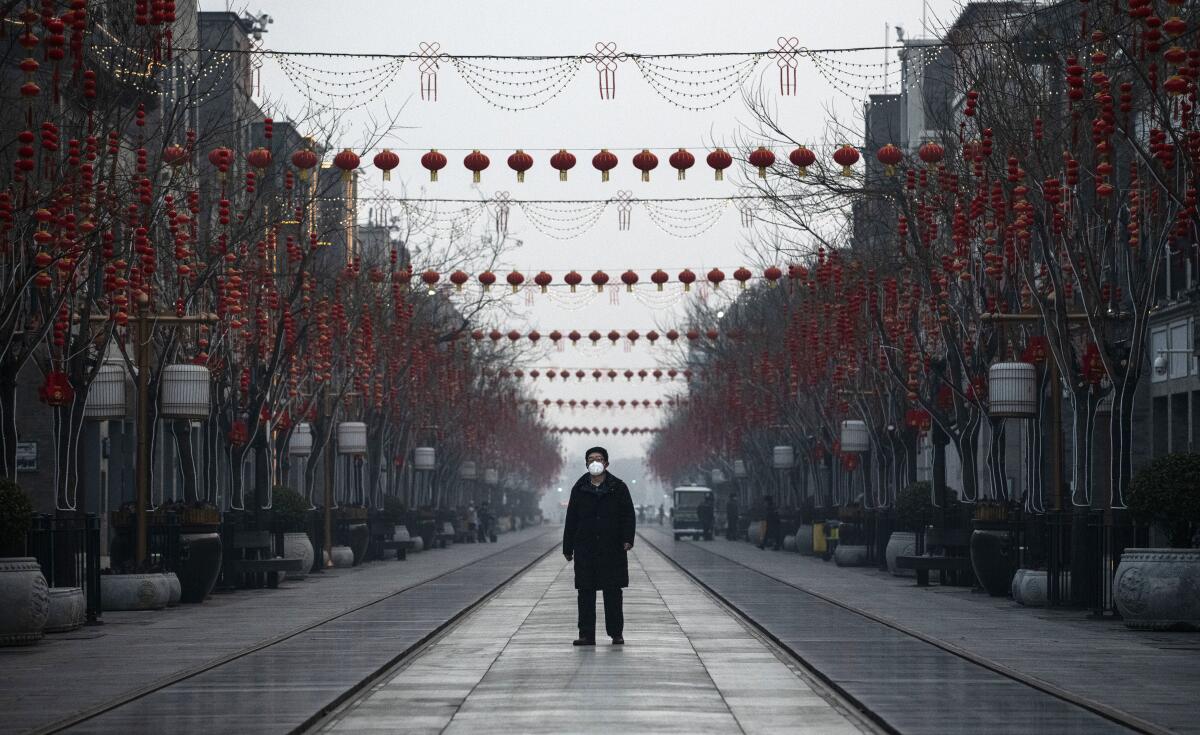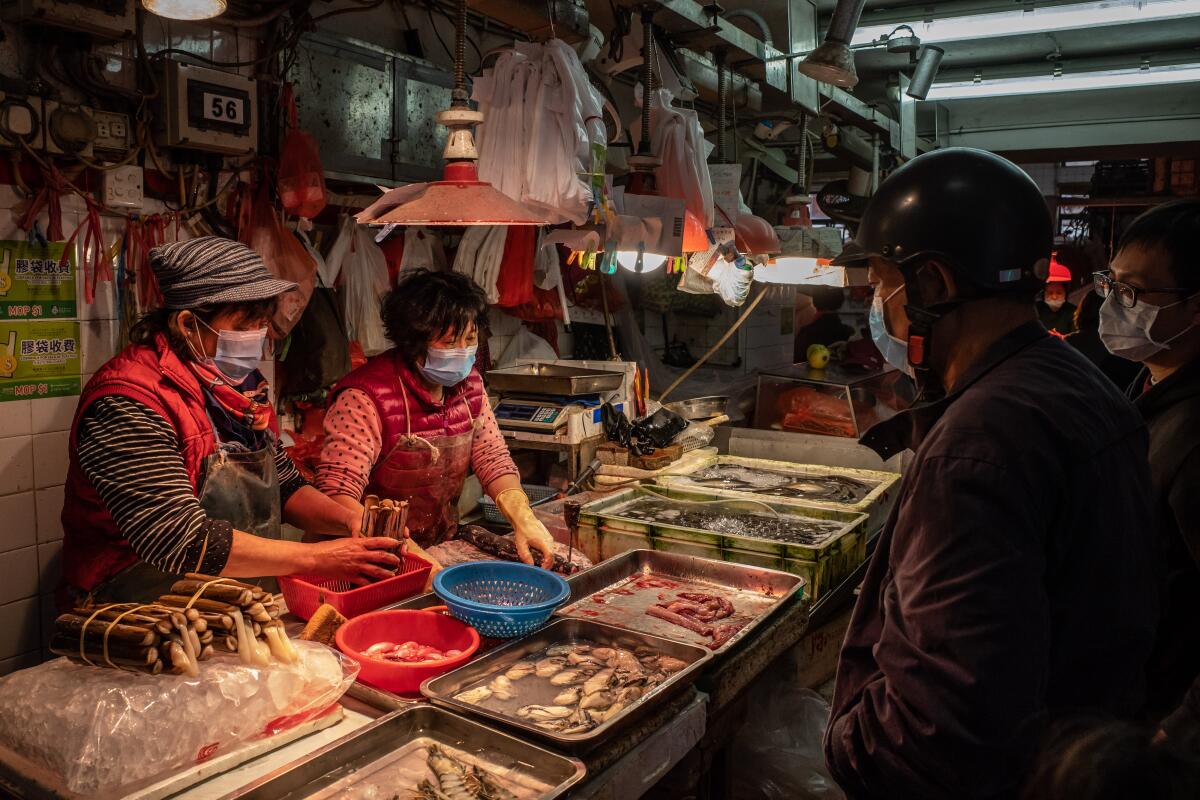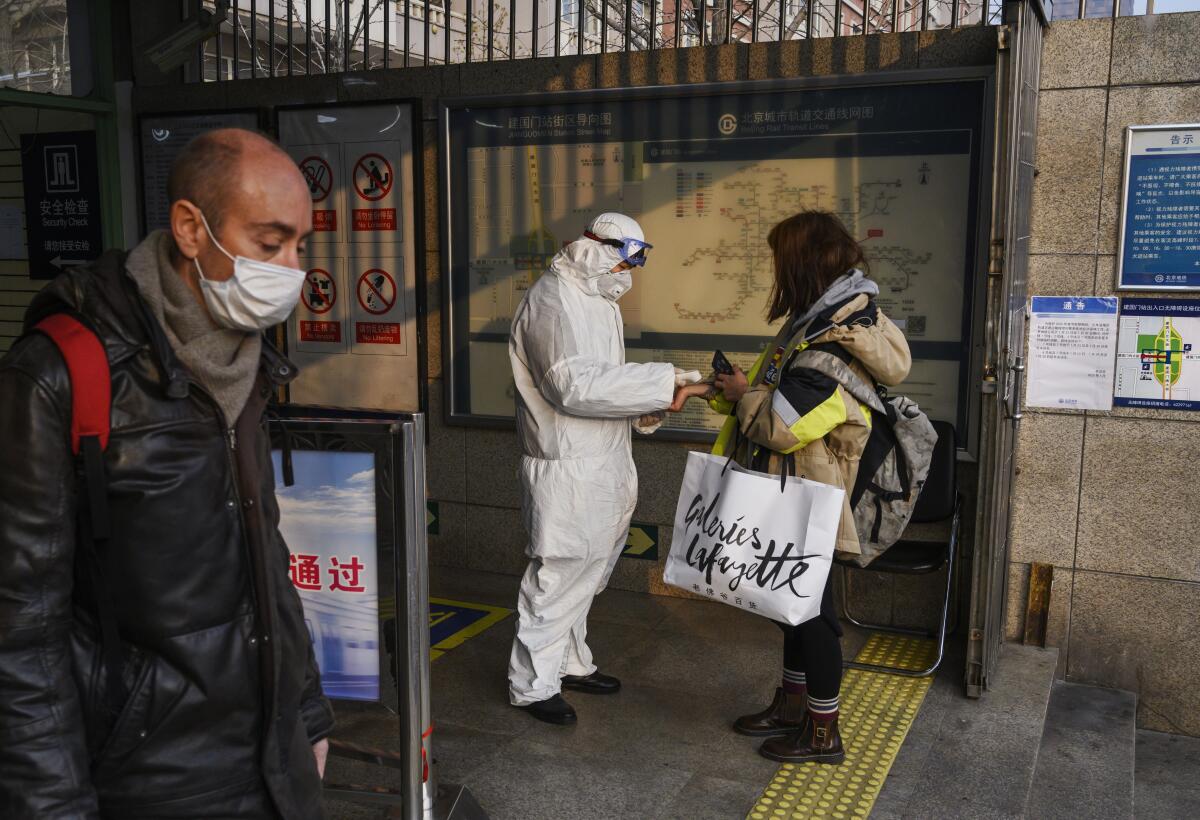China fires officials as coronavirus infections soar

- Share via
BEIJING — Political officials were fired and infection cases skyrocketed in China on Thursday, reminding a nation stuck at home and scientists watching worldwide just how little is known about the coronavirus outbreak that has infected at least 60,000 and killed more than 1,300 people.
Previous numbers had been reassuring, with daily confirmations of new infections dropping from several thousand to around 1,000. Officials in Beijing, increasingly worried about the economic toll of the outbreak, urged people to go back to work. State media ran editorials about resuming international flights to China.
But on Thursday the case numbers shot up. Chinese health authorities reported 15,152 new cases of COVID-19 — the World Health Organization’s new name for the viral disease — overnight. Hubei province, the epidemic’s epicenter, accounted for most of the increase: The number of infections went up by 14,840, more than nine times the 1,638 new cases reported there a day earlier.
Then came the purge. Beijing announced that both the Communist Party chiefs of Wuhan and surrounding Hubei province
were fired and replaced with officials known for “stability maintenance” and closely allied with party chairman and President Xi Jinping. The sackings followed earlier dismissals including the Hubei health commission’s party chief and its director.
The underreporting of the breadth of the epidemic, believed to have originated at a seafood market in Wuhan, has been blamed on officials who suppressed information on the outbreak to save face among their superiors.

Experts say the sudden increase in the number of confirmed infections, although alarming, is a step toward identifying and containing the illness.
The new figures don’t indicate a rapid overnight spread of the virus in Hubei, but rather a change in the way patients are counted there, which may provide better access to treatment on the front lines. New cases of COVID-19 are being confirmed based on symptoms and a CT scan of the patient’s lungs. Previously, confirmations were based on time-consuming lab tests, which created huge backlogs.
Many critically sick patients with symptoms but no confirmation of infection had complained of being turned away from hospitals. An unknown number have died without being diagnosed as having the virus. Nearly 90% of the new cases reported in Hubei on Thursday were “clinically diagnosed” under the new rules.
The change reveals China had been undercounting its COVID-19 cases. It is also a troubling reminder that there is no clarity yet on the extent or severity of the outbreak.
“The picture is evolving day by day ... it is a constantly moving target,” said John Nicholls, a pathologist at the University of Hong Kong who worked on the SARS outbreak in 2003. “We really have got no idea about the true number of cases.”
Both Chinese and foreign epidemiologists believe that a large number of mild COVID-19 cases have still not been counted. The reasons abound: a shortage of tests, overwhelmed caregivers, and many infected patients whose symptoms aren’t severe enough to qualify for tests, which are not always reliable.

Wang Chen, president of the Chinese Academy of Medical Sciences, told Chinese media Thursday that the change in reporting requirements was “extremely necessary” because the laboratory test to detect a particular sequence of nucleic acids often failed.
“Many patients who appeared to be [infected with COVID-19] based on their epidemiological history, contact history and clinical symptoms were not able to test positive on the nucleic acid test, and were listed as ‘suspected cases,’” he said.
Hubei province’s new reporting standards are an improvement, said Benjamin Cowling, head of the Division of Epidemiology and Biostatistics at the University of Hong Kong’s School of Public Health. “Is it 10 mild cases for every severe case? Is it a hundred mild cases for every severe case? That makes a big difference in how we think about controlling infections,” Cowling said, adding that he hoped the rest of China would also adopt Hubei’s reporting standards.
Peng Zhiyong, an intensive care unit doctor in Wuhan, said in an interview with the Chinese outlet Caixin that initial requirements for confirming coronavirus cases, including whether a patient had visited the Wuhan seafood market, were withheld from the public, making it nearly impossible to confirm new infections as the number of cases rose in early January.
“The diagnostic criteria were too harsh — with that criteria, it would be very difficult to diagnose anyone,” Peng said. “In this period, our hospital leadership reflected this to the health commission many times, and other hospitals were reflecting the same.”
On Jan. 18, Peng said, he complained to another group of visiting experts from the National Health Commission. “This makes it very easy to miss real patients,” he’d said. “This is an infectious disease. If the diagnostic criteria are too tight, the sick people we let go will be a great risk to society.”
Only after Jan. 20, when prominent SARS scientist Zhong Nanshan announced on state TV that there was human-to-human transmission of COVID-19, did Chinese authorities take serious action to contain the outbreak.
The timing of Thursday’s political shake-up — coinciding with fresh numbers closer to Hubei’s reality — suggests that Beijing wants the newly appointed leaders to be seen as problem solvers dispatched to fix a crisis that local officials had allowed to spin out of control. Xi’s aim is to prevent further public anger and ensure “social stability.”
The goals of scientists is to get accurate data and honest information. “The confirmed cases and even the probable cases are only reflecting the tip of the iceberg,” Cowling said. “We don’t really have a precise impression of what that iceberg looks like. We just know there’s an iceberg.”
More to Read
Sign up for Essential California
The most important California stories and recommendations in your inbox every morning.
You may occasionally receive promotional content from the Los Angeles Times.











